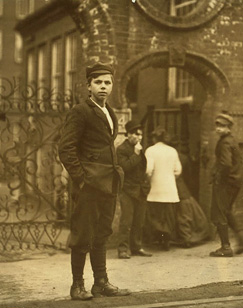industrialization & immigration
Polish Immigrants in the Valley
Farmers in the Connecticut River Valley recruited Polish immigrants to work the fields around Northampton, Hadley, and Sunderland. As the younger generations of farm families sought opportunities in the region's emerging industrial economy, Polish farm hands bought up fallow fields and built successful operations producing onions and tobacco.
Other Poles, recruited by mills and factories, abandoned their traditional rural lifestyles for urban life in Springfield, Ludlow, and Chicopee. The industrial towns provided an opportunity to keep families together and to associate with others from similar cultural backgrounds. In Chicopee, a Polish community began to form as new arrivals found comfort in a familiar language, customs and institutions.
For Polish immigrants, the most important institution was the Catholic Church. Father Patrick Healey of the Holy Name of Jesus parish in Chicopee took note of the growing Polish community and began helping its members secure food, shelter and work. In 1888, Chicopee's first Polish community organization, the St. Stanislaus Bishop and Martyr Society, was founded. The society began construction on a wood-frame building in 1891, and four years later there were 800 parishioners of Polish descent attending the new St. Stanislaus church. By 1897, the members had formed a parish school.
Most Poles at the time did not speak English, and most refused to join other Catholic parishes that served Irish and French-Canadian communities. Having their own parish provided the Poles not only with religious services but with a community center for those who had given up their homes, friends, and customs in the old country.
Acceptance into the mainstream of U.S. society came slowly for Polish immigrants. For newspapers and the larger public, "Polish" became a designation for all Catholic, poor, non-English speaking immigrants from an agrarian background. Nativist opposition lamented the immigrants' "ignorance" and susceptibility to corrupt politicians preying on gullible voters, as well as the potential for labor unrest among the "discontented elements" of the industrial towns. Factories and mills in the Connecticut River Valley frequently gave priority to French-Canadian and Irish workers over the Poles.
To counter such hostilities, Polish immigrants often changed the spelling of their names to appear more "American." One Chicopee settler, Josef Orgozalek became known as Joseph Ogozalek, and opened a dry goods store at 70 Main Street in the mid-1890s. Ogozalek took steps to help other immigrants assimilate and at night in his store offered classes in English and U.S. social customs.*
Renewed efforts at assimilation and community organization by Polish immigrants followed an episode of strikes and evictions around 1910. Labor unions were organized, and several Polish-American Citizens Clubs were formed to encourage recent arrivals to learn English and American history in preparation for citizenship exams. Polish-born Americans enthusiastically supported the Allies against the Central Powers during World War I with fundraising, patriotic parades, and military service. In 1918, a Springfield Union editorial noted the Polish immigrants' "unswerving support of the American cause."
Today, Elms College in Chicopee maintains a Polish Center dedicated to fostering an appreciation of Polish culture and heritage in Europe and the United States. The center is a testament to those immigrants who, arriving in the Connecticut River Valley in the late nineteenth century, overcame great obstacles to create another colorful strand in the American cultural mosaic.
*Stephen R. Jendrysik, The Polish Community of Chicopee (Charleston: Arcadia Publishing, 2005), 26-7.
